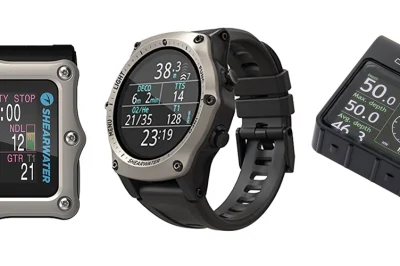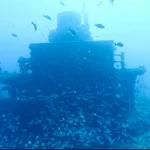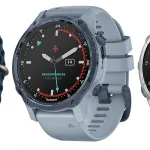Unveiling the Technology: How Dive Computers Sync with Cameras

Table of Contents
- Unveiling the Technology: How Dive Computers Sync with Cameras
- Debunking Common Misconceptions about Dive Computers
- Avoiding Mistakes: Common Errors When Using Dive Computers and How to Fix Them
- The Future of Underwater Photography: Trends in Dive Computer Technology
- Comparative Analysis of Dive Computers: Which Models Offer The Best Camera Sync?
- How Advanced Data Integration Enhances Underwater Photography
- Challenging the Status Quo: Do Traditional Dive Computers Suffice?
- Statistical Insights: The Impact of Synchronized Data on Dive Photography
Introduction
Explore how the latest dive computer technology is transforming underwater photography by syncing depth data directly with your camera timestamps. This game-changing integration provides scuba divers with new tools to enhance their photographic journey and ensure every moment beneath the waves is perfectly captured.
Unveiling the Technology: How Dive Computers Sync with Cameras
Debunking Common Misconceptions about Dive Computers
Dive computers have transformed scuba diving, yet several misconceptions can influence a diver’s purchasing decision. One prevalent myth is that entry-level computers lack synchronization capabilities. In reality, even these models allow for manual data logging and reviewing dive profiles through built-in memory. Users can often transfer their logs to dive log applications, which is a key feature for monitoring and enhancing their diving experiences.
Another misunderstanding is that Bluetooth and WiFi syncing are exclusive to high-end models. This is increasingly false, as many mid-range computers, like the Shearwater Perdix AI, incorporate Bluetooth functionality. This facilitates seamless data sharing between devices, although users may need to navigate initial setup and network configurations to optimise the syncing process.
Many believe that syncing requires a full download of data every time. However, after the first full synchronization, most systems shift to incremental updates, downloading only new dives. This makes subsequent syncing significantly faster and more efficient, allowing divers to easily access recent dive logs without the hassle of repeating the whole process.
Some divers may think that if syncing fails, the device is incompatible. Often, issues arise from network misconfigurations rather than device limitations. Checking settings, like file sharing or firewall configurations, can resolve these interruptions and enable smoother sync operations.
Finally, a misconception exists that using Nitrox disrupts data logging capabilities. Entry-level computers can accurately log dive profiles even when using enriched air, ensuring that safety algorithms remain effective. This feature is crucial for divers planning to utilise different gas mixes in various diving situations.
Debunking Common Misconceptions about Dive Computers
Common Errors When Using Dive Computers and How to Fix Them
Dive computers are invaluable tools for modern scuba divers, helping to manage decompression and monitor depth and time. However, their effectiveness can be compromised by common mistakes divers often make. Recognising these errors and understanding how to avoid them is essential for a safe and enjoyable diving experience.
- Forgetting to Turn On or Bring the Computer: One of the most critical mistakes is neglecting to activate the dive computer or forgetting it entirely. Without a functioning computer, divers cannot accurately track their dive profile.
- Solution: Always conduct pre-dive checks, ensuring the computer is operational and securely fastened. Develop a checklist, such as the BWRAF method (BCD, Weights, Releases, Air, Final Check), to confirm everything is in order.
- Overreliance on Computer Recommendations: Some divers may follow their dive computer’s guidelines without considering their physical state or environmental conditions, potentially leading to dangerous situations.
- Solution: Stay conservative in planning, adding safety stops and avoiding excessive depth or time for dives. Pay attention to personal hydration and rest before dives.
- Ignoring No-Decompression Limits: Divers sometimes exceed the no-decompression limits indicated by their computers, risking decompression sickness.
- Solution: Meticulously plan dives, using both the computer and manual dive tables for cross-verification, and always perform buddy checks.
- Post-Dive Altitude Exposure: Flying soon after diving can elevate the risk of decompression sickness, even if a dive computer does not indicate immediate danger.
- Solution: Adhere strictly to the no-fly time recommended by your computer to ensure safety.
- Mismanaging Computer Failure: Diving without a backup plan for potential computer failures can leave divers in precarious situations.
- Solution: Always carry a secondary device, such as a spare dive computer or manual dive tables, and know how to navigate without electronic assistance.
- Hasty or Inconsistent Equalisation: Delaying ear equalisation during descent can lead to discomfort or injury.
- Solution: Employ various equalisation techniques frequently throughout the descent.
- Failure to Review Dive Profiles After DCS Symptoms: In the event of decompression sickness symptoms, not having dive computer data available for medical evaluation is a missed opportunity.
- Solution: Retain the dive computer for review by medical professionals after experiencing DCS symptoms, as it provides crucial insights into dive exposure.
By understanding these common pitfalls and implementing the suggested solutions, divers can enhance their safety and enjoyment in the water.
Avoiding Mistakes: Common Errors When Using Dive Computers and How to Fix Them
Emerging Underwater Photography Trends (2025)
The advancements in underwater photography have seen tremendous innovation, fostering the need for divers to stay updated on the latest technologies and techniques that can enhance their photographic experiences underwater. Below are some key trends emerging in 2025:
1. Advanced Gear and Techniques
- Higher ISO Performance: New cameras are increasingly equipped with sensors that excel in low-light conditions, allowing photographers to capture sharper and less noisy images. This capability is particularly useful for challenging shots, such as split-level scenes where both underwater subjects and the surface atmosphere need to be captured delicately.
- Reverse Ring Macro: Adapters are being developed that allow standard lenses to achieve macro functionality. This trend opens up possibilities for extreme magnification of small subjects like corals and blennies, creating wonderfully detailed images that were previously difficult to obtain.
- Drones and Vertical Freedom: Consumers are incorporating drones, such as the DJI Phantom 4, to capture breathtaking aerial and dynamic underwater perspectives. This trend adds significant depth and dimension to underwater photography, allowing for unique compositions that traditional gear cannot achieve.
- Super Macro and Fisheye Lenses: Enhanced super macro capabilities enable photographers to focus on minute details, while fisheye lenses offer a wide-angle view, creating immersive experiences for viewers and unique visual narratives of underwater life.
2. Creative Applications
- Underwater Product/Model Shoots: Brands are now utilising submerged environments to create stunning product photography. This method emphasises both safety and artistic impact, showcasing fashion in surreal surroundings.
- Motion Photography: There is a growing trend towards capturing dynamic moments—like school fish or energetic divers—by employing techniques that mimic the intensity of video through freeze-frame or intentional blur effects.
- Fish-Eye and High-Angle Shots: Experimentation with extreme wide-angle perspectives or overhead views yields unique compositions, blending architectural elements with underwater settings for a wholly fresh visual approach.
Dive Computer Technology (2025)
No information was found in the provided resources regarding trends in dive computer technology. For insights on dive safety or technical advancements, further research may be needed.
The Future of Underwater Photography: Trends in Dive Computer Technology
Analysis of Dive Computers for Camera Sync Capabilities
As modern underwater photography evolves, divers increasingly seek dive computers that integrate seamlessly with camera systems to enhance their shooting experience. The synergy between dive data and photographic timestamps enables divers to log dives with precise context, enriching both digital archives and storytelling. Below, we analyse the standout dive computers that offer Bluetooth connectivity or integration with smartphones, paving the way for accessible underwater photography workflows.
Top Dive Computers with Bluetooth Connectivity
- Shearwater Perdix 2
- Features Bluetooth for syncing with the Shearwater Cloud app, allowing divers to manage dive logs on their smartphones.
- This model’s interoperability with third-party apps such as Dive++ and Logbook Divers provides a platform to timestamp dive data alongside photo metadata.
- Garmin Descent Mk3i
- This device is equipped with Bluetooth, Wi-Fi, and Subwave sonar for diver-to-diver communication, enhancing dive group coordination.
- Syncing with Garmin Connect allows users to aggregate dive data, which can be correlated with photo timestamps manually to maintain consistency across media.
- With high GPS accuracy (±2m), it’s particularly useful for geotagging images, added to its robust feature set for dive tracking.
- Apple Watch Ultra
- Designed to integrate specifically within the iOS ecosystem, this watch pairs effortlessly with compatible apps, providing a streamlined experience.
- Although it doesn’t offer air integration, it can log dive data with timestamps when used with supported app systems, such as Open Ocean.
Budget-Friendly Options
- Aqua Lung i470TC
- This economical option provides basic Bluetooth connectivity for syncing dive logs, making it suitable for snorkelers and entry-level divers.
- Mares Puck 4
- Another affordable model with simple Bluetooth options, ideal for those just starting in underwater photography.
Key Buying Considerations
- Direct Sync Limitations: As of 2025, direct camera sync features remain scarce, but Bluetooth capabilities facilitate indirect data sharing through smartphone applications.
- App Compatibility: Prioritise models with established app ecosystems like Shearwater and Garmin, which automate data integration.
- Accuracy: Models such as the Garmin Mk3i and Perdix 2 offer exceptional depth measurements, crucial for documenting photographic conditions accurately.
Combining these dive computers with specialised apps such as Dive Media or Adobe Lightroom can effectively replace the need for direct camera sync, enhancing workflow and efficiency during underwater photography.
Comparative Analysis of Dive Computers: Which Models Offer The Best Camera Sync?
Advanced integration technologies in modern dive computers significantly enhance safety, efficiency, and connectivity, while the integration of underwater photography features remains a developing area. Here’s a detailed analysis of key advancements in dive computer technology that can enrich your diving experience and, indirectly, your photography.
Air Integration & Tank Management
Air-integrated dive computers, such as those from Mares, track tank pressure using wired or wireless transmitters and calculate remaining air time based on depth and individual breathing rates. This feature is crucial for divers to manage their gas supply efficiently during dives. Many advanced models now allow for hoseless tank data, enabling users to monitor multiple tanks simultaneously, which is beneficial for technical diving or extended excursions into deeper waters.
Data Presentation & Customisation
Modern dive computers emphasise intuitive data presentation. Devices like the Oceanic+ app for Apple Watch Ultra and the Shearwater G2 offer colour displays with customisable layouts. For instance, the G2 provides two display modes: the Essentials-first mode for large, simplified data presentation and the Advanced data walls that showcase detailed dive metrics. Additionally, advanced gradient-factor algorithms are used in some models to ensure precise computations of dive metrics, thus enhancing safety during technical dives.
Third-Party Platform Integration
Integration with platforms like Dive Buddy allows divers to sync their dive logs seamlessly with community-driven applications. Key features include:
- Automated data transfer from dive computers to apps.
- Easier sharing of dive experiences through user-generated content.
This integration fosters a sense of community and boosts visibility for user achievements within diving circles.
Underwater Photography Integration
Although specific features for underwater photography remain limited, some dive computers, like the Shearwater G2, allow users to upload images, indicating a potential for future integrations between dive data and photographic management. This suggests that the next wave of dive computers might incorporate features that enhance the quality and contextuality of underwater photography further.
How Advanced Data Integration Enhances Underwater Photography
Top Dive Computers for Underwater Photography in 2025
As underwater photography continues to evolve, divers require more than just a basic dive computer. Selecting the right model that facilitates both safety and the artistic process is essential. Here are the key features to consider when choosing a dive computer specifically tailored for underwater photography:
- High-Visibility Display: A vibrant and clear display is crucial for underwater visibility, enabling divers to quickly check important data like depth, time, and gas levels without distraction.
- Air Integration: This feature monitors tank pressure in real-time, ensuring safety during extended photography sessions where a diver may need to spend longer underwater.
- Data Logging: Bluetooth or USB connectivity allows for easy syncing of dive profiles, making it simpler to analyse your photography sessions post-dive.
- Compact Design: A smaller, less obtrusive design minimises bulk, allowing photographers to manage camera gear without hindrance.
Recommended Models
| Model | Screen | Air Integration | Data Sync | Key Features |
|---|---|---|---|---|
| Shearwater Teric | Colour AMOLED | Yes | Bluetooth | Customisable display, trimix support, user-friendly interface |
| Shearwater Perdix 2 | High-res LCD | Yes (up to 4 tanks) | Bluetooth | Tech-diving capabilities, AA batteries, CC/BO modes |
| Suunto EON Core | Rechargeable LCD | Wireless transmitter | USB recharge | Large screen, matrix display, Bluetooth |
| Aqua Lung i450T | Matrix screen | Wireless | Cable | Watch-style, 10-year durability, Nitrox support |
| Suunto D6i | Digital compass | Optional transmitter | Bluetooth | Stylish design, metal casing, dive log sync |
Feature Breakdown
1. Shearwater Teric
- Best Overall: Features a vibrant colour AMOLED screen for excellent readability in low-light conditions.
- Tech Accommodations: Supports advanced diving modes such as trimix and closed-circuit, making it great for serious underwater photographers.
- Customisation: Allows users to tailor their display for specific metrics that are most relevant to photography, like depth or gas levels.
2. Suunto EON Core
- Readability: Offers a large LCD screen that minimises eye strain during lengthy dives.
- Convenience: Rechargeable batteries coupled with Bluetooth syncing streamline the process of analysing dives.
3. Aqua Lung i450T
- Compact Design: Its watch-style design minimises bulk, causing less interference with camera equipment.
- Reliability: It has proven durability, with many divers reporting over a decade of usage.
4. Shearwater Perdix 2
- Technical Flexibility: Suitable for experienced divers with multi-gas support and user-replaceable AA batteries.
- Practical Power: Ensures reliability during long expeditions, making it a favourite among tech divers.
Final Recommendations
- Recreational Photography: Consider the Shearwater Teric for its exceptional display or the Aqua Lung i450T for its compactness.
- Tech-Driven Photography: The Shearwater Perdix 2 is ideal for its advanced features tailored for technical diving.
- Budget-Friendly Option: Suunto D6i provides a balance of functionality and style at a more accessible price point.
For underwater photographers prioritising visibility, the Teric’s AMOLED screen sets a high standard, while the Perdix 2 caters well to technical environments with its advanced gas management capabilities.
Challenging the Status Quo: Do Traditional Dive Computers Suffice?
As underwater photography continues to evolve, synchronized depth data from dive computers and cameras enhances image quality and utility in meaningful ways. Integrating depth information with camera timestamps significantly influences the artistry and scientific applications of underwater photography.
Innovations in camera technology have embraced the concept of depth sensing, providing divers with tools that enable effective image capture tailored to their underwater environment. One such advancement is Apple’s depth-capture technology. By utilising frameworks that allow simultaneous acquisition of both visual and depth data, divers can leverage depth-based adjustments during image capture. This capability can enhance focus accuracy or create specific blur effects tailored to the underwater landscape. When synchronized with dive computers, this depth data can also help in environmental mapping and ecological monitoring.
Systems like the DIVEVOLK underwater housing demonstrate practical applications of this technology. While it allows for comprehensive control over camera settings, its open platform might support external depth log data, facilitating metadata integration into diving logs. This capability makes it easier for divers to track environmental conditions and improve their photographic captures.
Consider the technological marvel of the Sony A9 III, which eliminates rolling-shutter distortion thanks to its global shutter feature. This improvement means divers can achieve precise flash synchronization even under challenging lighting circumstances. It also supports advanced, time-synchronized exposures, which are vital when photographing fast-moving underwater subjects.
The impact of synchronized depth data on dive photography extends beyond mere aesthetics. It positively influences autofocus systems, empowers better post-processing options through synthetic depth maps, and enhances environmental assessments of marine ecosystems. Furthermore, creative applications become feasible, allowing for techniques that minimise backscatter through synchronized flash and strobe systems, thereby elevating the final image quality.
Statistical Insights: The Impact of Synchronized Data on Dive Photography
Essential Features for Underwater Photography Dive Computers
Underwater photographers require dive computers with specific features to balance safety, efficiency, and multitasking demands. Key functionalities include:
Core Safety & Real-Time Monitoring
Dive computers play a crucial role in tracking depth, time, and water temperature, which helps to calculate no-decompression limits and ascent rates dynamically. For photographers focused on their shots, these tools automate safety checks and reduce the need for manual calculations, allowing them to concentrate on their craft while ensuring their safety.
Ascent Rate Alarms
Most computers display ascent speed via arrows, colour coding, or beeps, ensuring compliance with slow ascent rates even when distracted by camera work. Some models integrate auditory alerts to overcome underwater sound-direction challenges, providing an extra safety layer for photographers who may not notice visual signals immediately.
Wireless Air Integration
Advanced wrist-mounted devices allow for wireless monitoring of tank pressure without needing to check submersible pressure gauges (SPGs). This feature frees hands for camera adjustments, making it particularly beneficial for photographers managing multiple pieces of equipment simultaneously.
Post-Dive Analysis & Logging
Computers with PC compatibility enable users to export dive profiles, including depth versus time charts and detailed metrics like nitrogen loading, ascent violations, and air consumption. These logs are invaluable for photographers as they help refine future dives and correlate shooting sessions with environmental conditions.
Multi-Dive Flexibility
Advanced algorithms optimise decompression stops for varied dive profiles. This flexibility is essential for photographers who often switch between shallow and deep photo spots, enabling them to efficiently manage their safety while pursuing their artistic vision.
For optimal underwater photography setups, prioritise computers focused on wireless air integration, ascent rate vigilance, and dive log software to maximise both safety and creative output.
Sources
- Florida Scuba Diving – The Shocking Truth about Entry-Level Dive Computers
- Florida Scuba Diving – Dive Computer Comparison for 2025
- Diving Log Forum – Syncing Issues
- DANSA – Your Dive Computer: Tips and Tricks (Part 1)
- ScubaBoard – Preparedness for Dive Computer Failures
- Diving Right In Scuba – Common Beginner Scuba Mistakes
- Suunto – Safety After Dive
- DANSA – Your Dive Computer: Tips and Tricks (Part 2)





